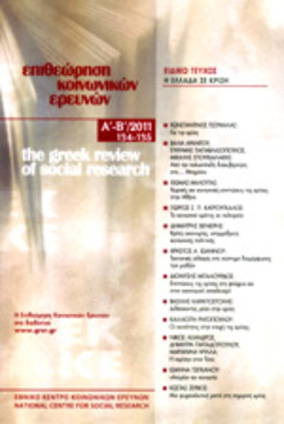The "white" ethnic racism" thesis : Application to Greek Americans
Part of : Επιθεώρηση κοινωνικών ερευνών ; Vol.32, 1978, pages 90-102
Issue:
Pages:
90-102
Section Title:
Articles
Abstract:
The present report used data collected predominantly from second-generation Greek-Americans to test the white-ethnic racism thesis. The thesis states that the descendants of «new immigrant» groups— especially their working class descendants, are prejudiced toward minorities, particularly toward blacks. Two approaches were used to evaluate thethesis.In the first approach, a number of ethnic indicators (e.g. demographic, attitudinal, cognitive, andbehavioral) were compared to the respondent’s levelof tolerance toward Jews and blacks. Some association between «Greekness» and prejudice was noted. There was no uniformity, however, across indicators, with some ethnic indicators (e.g. low assimilationorientation) being correlatedwith intolerance towardthe Jews and other ethnic indicators (e.g. number ofyears in Greek school) being associated with rejection of stereotypes about blacks. In addition, therewere few strong correlations between the various ethnic indicators and prejudice. Finally, some of theassociations between ethnicity and prejudice werenot robust when more.traditional correlates of prejudice. such as educational level and authoritarianism, were controlled. Thus, the ethnic factors had a limited predictive capacity. This, however, doesnot mean that the «universal» correlates of prejudice, such as education and authoritarianism, cannot interact with cultural tradition to produce a highlevel of racism.The white-ethnic racism thesis was also testedunder standardized conditions of economic status. Two indices of economic status, reported annual income and the rental value of the respondent’s dwelling, were used. Once again there was no uniform support for the thesis. There was more support forthe thesis («Greekness» associated with prejudiceunderlow economic status) when rental value, ratherthan income, was used as the economic variable. Inpart this may be due to the better distribution of therental value than the income factor. It may also be afunction of the differential meaning of the two status indicators to the Greek-American respondents. The rental value status is more interwoven with house ownership which is a more tangible and overt indicator of status than income. In addition, housing hasbeen associated with fears about desegregation.There was more support for the white-ethnic racism thesis in the case of stereotypes about blacksthan attitudes toward the blacks (social distance) or attitudes toward the Jews. This may be due to thefactthat the stereotype measure contained content evoking the Greek-American’s «bootstrap attitudes».According to this attitude, the descendant of the newimmigrant claims that his ancestors were also the victims ofnordic prejudice, but diligence, individual effort, and patience led to their contemporary success.Thus, they feel they can not be sympathetic with agroup who they think is demanding rewards without commensurate efforts.The «bootstrap» mentality assumes a parallelism of experiences between the white ethnics and racialminorities. This parallelism, however, breaks downwhen other objective factors are taken into account.First, the degree of prejudice against white ethnicscannot match the degree of overt, organized racismagainst blacks. In part, this is the result of the ethnicsbeing a «cultural» rather than a «racial» minority. Inpart, it is due to the fact that the blacks have had the stigma of slavery at the hands of the «dominant» WASP group. Finally, the «white ethnics» came tothe US at a time (1880-1930) when the country wasindustrializing and offered much opportunity for entrepreneurial success. When the blacks really began «arriving» in the US (i.e. when their genuine liberation began in the 1940s and 1950s), the US technology was exceedingly complex and the business opportunities were more limited. These factors, however, are rarely considered by the descendants of whiteethnics whose relative status is being challenged bythe just demands of the racial minorities.The findings ofthe present study — and the attendant interpretations — can only be suggestive. Thereis a need to obtain better variation on the ethnicity variables such as generational status and regionalorigin. Along the same lines, better variation must besought in the prejudice measures. In the presentstudy, two of these measures (attitudes toward theJews and social distance attitudes toward the blacks)were not as well distributed as the black stereotypemeasure. Thus, some of the findings may be due tomethodological rather than theoretical reasons. These problems can be rectified if research is carried out in large Greek communities such as Chicago and New York. The white-ethnic racism thesis can, ofcourse, also be tested on other «white-ethnic» groups from Southern and Eastern Europe, both on themicro- and macrosociological levels of analysis.
Subject:
Subject (LC):




